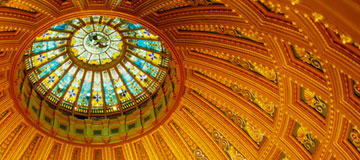Surprising Springfield—An Access Overview
What makes a great accessible destination? Obviously not just ramps, designated parking and adapted restrooms. There also has to be a variety of great attractions that appeal to different tastes and ages and that are also relatively barrier-free. Location, transportation, hotels, restaurants and other services are important variables as well. Finally, the community and its attitudes play an important, no less tangible role in creating a pleasant, welcoming environment.
So how then does Springfield measure up? By all the above criteria, Illinois' capital city is doing an impressive job for both residents and visitors with disabilities. Of course, there's always more to be done, but Easy Access Springfield should demonstrate how much has already been achieved by both private businesses and governmental entities. As to community spirit, the private fundraising and volunteer efforts devoted to the building of Southwind Park, the new, fully-inclusive public recreational facility, speak for themselves. Due to open in summer 2010, Southwind Park sets the highest standards for not only accessibility but also environmental sustainability. A new children's museum, Springfield's first, will also be built at the new park in the next few years.
In Lincoln's Footsteps
Even though most of Springfield's attractions are historic sites, this won't prevent visitors who use wheelchairs from also following in Lincoln's footsteps. Credit must go to the Illinois Historic Preservation Agency (IHPA) and the National Park Service for providing basic access in a non-obtrusive way to structures dating back to the mid-1800's such as the Lincoln Home, Lincoln Law Office, Old State Capitol and even a few log cabins at New Salem. They also do their best to accommodate sensory disabilities and have created three wonderful Visitor Centers—Lincoln Home, New Salem and Union Station.
The Abraham Lincoln Presidential Library and Museum, which draws more than a half million visitors a year, is also the creation of IHPA. This new historic attraction makes use of the most modern technology to create exhibits and shows that speak to all age groups and abilities. History truly comes alive here. For the Lincoln Birthday Bicentennial in 2009, IHPA also created a History Link Cell Phone Tour with information for Springfield's most popular sites.
Arts in the Heartland
With a population of just 117,000 and a compact, well-groomed city center, Springfield has a small-town feel. The pace is slow and the people helpful and friendly. At the same time, however, because this is the state capital, Springfield has a vibrant arts scene and a wealth of cultural institutions including a symphony orchestra and ballet company. Accessible venues for the performing arts include Sangamon Auditorium, Hoogland Center for the Arts, and the Municipal Opera which stages open-air musicals by Lake Springfield. For fine arts lovers, the Springfield Art Association and Prairie Art Alliance mount shows throughout the year. There are also a number of accessible galleries and gift shops downtown that feature the works of local artists.
Fun for Families
The Illinois State Museum has wonderful natural history exhibits with lots of opportunities for hands-on learning. Route 66, which runs right through Springfield, draws kids of all ages to such nostalgic attractions as Shea’s Gas Station Museum and the Route 66 Twin Drive-In. While access there and at Springfield's amusement parks is somewhat limited, visitors can use the details in this guide to decide whether these attractions will meet their specific needs. Depending on the season, families can also enjoy a night of Springfield Sliders baseball or Jr. Blues hockey. By far the biggest family event in Springfield is the Illinois State Fair, held each August and offering a seemingly endless number of agricultural-based exhibits, demonstrations and concerts. The carnival rides, however, are not accessible.
Springfield’s affordability also helps make it a great family destination. Some of the city’s most accessible hotels, like the Microtel Inn, are also the least expensive, and there are good restaurants in every price range. In addition, many of the historic sites are either free or ask just a modest donation.
Parks and Nature
As Southwind Park demonstrates, Springfield Park District is dedicated to making its facilities inclusive and even offers adaptive carts at its four golf courses. There are also lifts at indoor and outdoor pools, accessible tennis courts and 15 miles of paved bike trails. Washington Park Botanic Garden, with its glass house and surrounding flower gardens, is one of the city's most scenic spots. Another must for nature lovers is the Lincoln Memorial Garden on Lake Springfield which boasts more than six miles of trails including an accessible prairie trail. Boating is also possible thanks to the Lake Springfield Marina which has accessible docks and pontoon boats for rent. The city plans to build a barrier-free fishing pier at one of the lakeside parks in the near future.
Transportation and Tours
Springfield is small enough that one can visit most downtown attractions without a vehicle. Well-maintained streets and sidewalks with good curb cuts make getting around easy for everyone. Springfield Walks offers a variety of theme tours, most of which are accessible to participants in wheelchairs. For those who prefer to ride, both Springfield Trolley Tours and the SMTD Historic Sites Bus use lift-equipped vehicles. Although Springfield has no accessible taxis as yet, several companies do provide transportation in adapted vans. Paratransit service is also available with advance registration.
Lodging and Restaurants
Springfield’s hotels and motels are clustered in the northeast near the State Fairgrounds, southeast near Lake Springfield, and southwest near the main shopping malls, as well as downtown. None are further than 20 minutes from the city center. The two largest and most upscale properties, which host most conferences, are the Hilton Springfield downtown near the Convention Center and the Crowne Plaza in the southeast. In general accessibility is good, with newer properties more likely to have better access.
While the various hotel zones have a good variety of accessible chain restaurants, the best locally-owned places to eat are mostly downtown including Maldaner’s, Augie’s Front Burner, and Saputo’s. Other local favorites are Fritz’s Wagon Wheel, Mariah’s and D'Arcy's Pint in the southwest and Chesapeake Seafood House in the northeast. The latter, set in a Lincoln-era mansion, has ramped access.
Getting There
With St. Louis only 80 miles away and Chicago less than 200, many visitors choose to fly into these major cities and then drive to Springfield. One can also fly directly into Capital Airport which has jetways and is only 20 minutes from downtown. All the major rental car companies have facilities in Springfield. The city also has an Amtrak station just two blocks from the Old State Capitol and a Greyhound bus terminal, both of which provide accessible service.
Easy Access Springfield
One other element required to make a destination truly accessible was purposely left off the list at the beginning of this overview. It's something only a very few cities currently have—a detailed access guide that enables visitors and residents with disabilities to easily plan their trips and outings. With the publication of Easy Access Springfield online and in print, this final element is now in place as well. Hopefully, this will encourage many more families who have a child, parent or grandparent with a physical, sensory or cognitive limitation to come and discover Lincoln's Home Town for themselves.
The Illinois Department of Commerce and Economic Opportunity provided the funding to make this rare resource possible. It joins Easy Access Chicago as the second in the series from Open Doors Organization.
Laurel Van Horn
Project Director/Editor
Open Doors Organization




